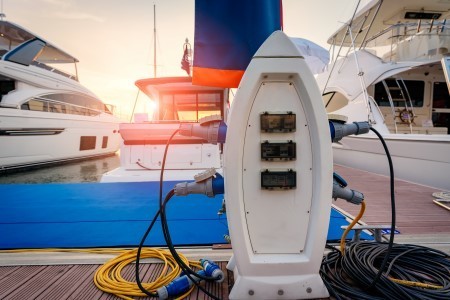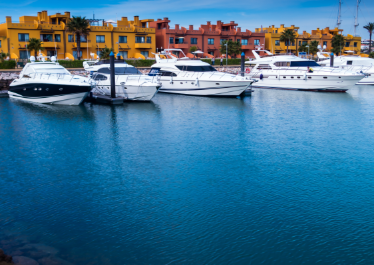Marine battery charger: All you need to know

Whether they are used to start the engine or to ensure the electrical operation of on-board equipment, batteries are an essential element on board boats. But to operate properly, batteries need a battery charger. How often should a marine battery be charged? How to choose a good battery charger? Follow the guide to find out everything you need to know!
Battery charger: what is it?
The battery is to a boat what the gas tank is to a car: a reserve of energy essential to the proper operation of the equipment. Of course, after a certain amount of use, the energy level contained in the battery is discharged and you need to recharge it. This is where the battery charger comes in.
Specifically, the role of the battery charger is to take power from a source, usually 115V or 220V, and convert to 12, 24 or 48V DC, depending on the voltage of the batteries, to charge them. On large boats, there is usually an autonomous energy source, a diesel generator, to which it is possible to connect AC equipment including the battery charger. It is important to understand that the battery charger itself needs energy, it does not work autonomously. On smaller boats, you have to wait until you are back to the marina and connect to a 220V socket and thus recharge the various batteries on board.
Starting battery, service battery, emergency battery: what are the differences?
On board a boat, there are 3 main families of batteries, according to their types of applications. As they meet different needs, they have different technical characteristics.
Starting battery
As its name indicates, the purpose of the starting battery is to start the boat's engine, in the same way as a starter battery on a car. To do this, the battery must be able to deliver high peak of power during a very short time. A starter battery can easily be used multiple times before needing to be recharged, because as soon as the boat starts, the engine's alternator will recharge it.
Service battery
Refrigerator, lights, autopilot... The service battery is used to power all the equipment on board that runs on direct current. Since it is used throughout the navigation period, it must function over time. Technically, this means that the battery must be capable of longer charge and discharge cycles than a starter battery.
Emergency battery
Backup batteries are usually found on boats of a certain size. It is a back-up solution, which will only be used in case of an emergency (radio, emergency light for example). Thus, the backup batteries must have a long life, to be able to play their role as a backup energy reserve in case of need.
Good to know: If the backup battery is optional, it is necessary to have two separate batteries to start and power the on-board equipment. If only one battery is used for both purposes, the boater runs the risk of not being able to start.

Boat battery chargers: how often should you recharge your batteries?
During the summer months, or at least when boats are used regularly, it is better to recharge your service batteries when you are back to the marina. The real problem in terms of charging frequency is during the winter period, when the batteries remain unused for long periods.
It is an immutable rule in the world of batteries: if they are not used, they naturally discharge. This is called self-discharge. The rate of self-discharge of a battery depends on its quality. A standard boat battery can self-discharged by 5% each month. For a boat that is wintered on land for many months, with a self-discharge rate of 5% per month, charging may fail to restore full capacity. This is why it is recommended to use a battery charger during the wintering period. This is what some boat maintenance companies are offering full winterizing care program.
The life of batteries is associated with the number of charge cycles they can withstand. Depending on whether a lead-acid, gel, AGM or lithium battery is used, the number of charge cycles can vary greatly.
In any case, regular use of a battery will extend its life. If you take care to recharge your batteries regularly, they can last 3 to 4 years. If you leave your batteries inactive during the winter period, without recharging them, you can end up with a dead battery after one season. So this is not a subject to be taken lightly!
Common Mistakes to Avoid When Using a Marine Battery Charger
To ensure the longevity of your batteries, it's essential to steer clear of certain bad practices.
1. Battery Overcharging
Overcharging is a primary culprit behind premature boat battery deterioration. Leaving batteries connected to a charger for extended periods beyond their maximum capacity can result in irreversible damage, such as degradation of internal plates and increased heat generation. To prevent overcharging issues, it's advisable to use a charger equipped with an automatic cutoff function that activates when the battery reaches full charge.
2. Battery Undercharging
Prolonged undercharging can also harm marine batteries. They require adequate charging to maintain energy storage capacity and overall performance. Repeated undercharging can lead to sulfation of internal plates, diminishing the battery's ability to hold a full charge. To avoid this pitfall, use an appropriate charger to deliver the correct current required for complete battery charging.
3. Using an Incompatible Marine Battery Charger
Different battery technologies, such as lead-acid, gel, AGM, and lithium, require specific voltage and current charging profiles. Not all chargers are compatible with all types of batteries. Using the wrong charger can lead to overcharging or undercharging, significantly reducing a battery's lifespan. Selecting a high-quality charger explicitly designed for marine applications is crucial to providing a stable and regulated charge.
Why Is Choosing the Right Battery Charger for Your Boat Important?
Selecting the appropriate charger plays a vital role in the performance of your batteries, which, in turn, affects your boat's smooth operation. Batteries power various electrical systems, including lighting, communication equipment, and household appliances. Ensuring that batteries receive proper charging is essential for yachters to enjoy optimal performance during sea outings. Additionally, since batteries represent a significant investment, maintaining their durability is paramount. Choosing the suitable charger enables your batteries to operate at their full potential.
Choosing the correct boat battery charger is also crucial for safety reasons. Overheating, short circuits, and fires are potential risks, and the charger should incorporate necessary safety features to ensure users can recharge their batteries with complete peace of mind.
Lastly, it's worth noting that some boats require fast charging for intensive use, while others necessitate slow, regular charging, suitable for long periods of inactivity. The choice of charger should consider the boat's energy requirements and associated sailing style, whether it's a motorboat or sailing boat. The criteria for selecting the best energy production solution will vary depending on the boat's intended use.
Boat battery chargers: what criteria should you use to choose?
- The charger's power: To size the charger's power that is best suited to your battery bank, there is a simple rule, which consists of taking between 10 and 20% of the capacity of the service batteries to define the charger's power. For example, if the service battery has a capacity of 200Ah, you will need a battery charger of 20 to 40 amps maximum. Standard marine battery will not accept more than 25% of their capacity.
- A battery charger designed for marine environment : for your electronic products to withstand salt spray, they must be "tropicalized", i.e. protected from the marine environment.
- The charger must charge different types of batteries with dedicated charging settings: be aware, for example, that not all chargers offer settings for lithium batteries.
- The number of outputs of the charger: as a minimum, it is recommended to have a dual-output battery charger, which will be able to recharge both the starter battery and the service battery system. Most of automotive or industrial battery charger only feature single output.
- The waterproof rating: depending on where the battery charger is located, the IP protection should be more or less high. For example, on a RIB with a charger in a trunk that is likely to be rinsed, it is better to choose a charger with an IP 65 waterproof rating, which guarantees that it is waterproof.
- The ability of the charger to operate in hot environments. Poor quality chargers tend to reduce their charging capacity as the temperature rises. If the charger is located in an engine compartment, its performance could plummet as soon as it reaches 40°, which would increase the time needed to recharge the batteries. Therefore, choose battery chargers that remain efficient beyond 50 or even 60°.
- Noise: be aware that some chargers have a ventilation system that is more or less noisy. On a sailboat, if the charger is located in a berth, choose a silent charger to preserve comfort on board...
- The brand's reputation. We can only advise you to choose a reference brand that has proven itself.
As a marine specialist, Dolphin Charger offers its customers 4 ranges of battery chargers, from 10 to 100 amps. From pleasure craft to professional boats, Dolphin's ranges meet all needs, without ever giving up quality and reliability. Discover our PROLITE series!


